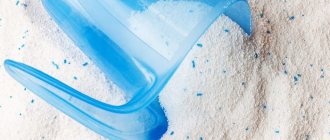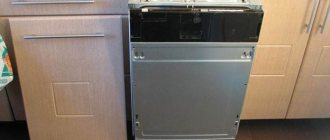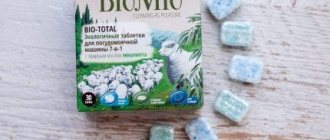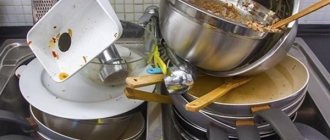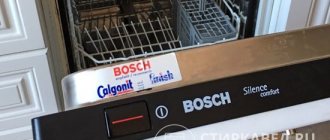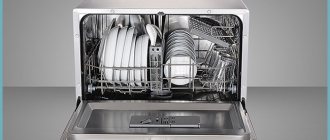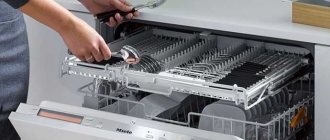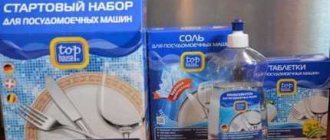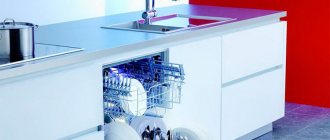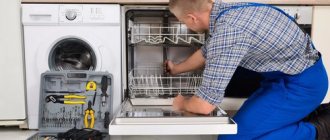Timely maintenance of equipment that is used daily is an important condition for its long service life. Parts of the dishwasher mechanism come into contact with impurities contained in the water. As a result, some structural elements fail.
This is the main reason why the service life of the device is reduced. You can influence internal processes, stop or prevent their development. Dishwasher salt is used for this purpose. It must be used on an ongoing basis, subject to certain conditions.
What is it for?
Tap water used for washing dishes contains impurities. These are substances that change the properties of a liquid under certain conditions, for example, due to heating. As a result, scale forms on some parts (heating element, tube walls).
The content of dissolved calcium and magnesium compounds leads to such consequences. When exposed to high temperatures, they settle on surfaces, where they gradually harden.
It is impossible to remove plaque in the usual way. It is necessary to use aggressive cleaning agents (acid-based), but even these do not always solve the problem. You will have to contact the service center. In the most severe cases, the elements of the mechanism are replaced.
If you use salt, your equipment will be maintained unnoticed. At the same time, it is poured inside the mechanism, for which a special compartment is provided.
Be sure to add dishwasher salt from time to time. But the peculiarities of using the substance are taken into account: its unrestricted use in violation of the rules is unacceptable.
How water hardness level affects salt consumption
Here the relationship is direct: the harder the water, the more chlorine ions are needed to soften it in the ion exchanger. Therefore, before using your dishwasher, you need to find out how hard the tap water you are using is.
In Russia, the level of water hardness is measured in degrees (°Zh). One degree corresponds to a concentration of magnesium and calcium salts equal to 0.5 millimoles in a volume of liquid of 1 liter, or 1 mEq/l. It should be noted that water hardness is measured differently in different countries. For example, one Russian °Zh is equal to 2.8 German degrees (dH).
A schematic representation of the water cycle in nature shows at what stage magnesium and calcium salts enter the liquid
In different regions of Russia, water can vary greatly in the level of Mg and Ca compounds. It all depends on the soils in which the beds of streams, rivers and lakes are located. Water is divided according to its hardness level:
- for soft – the salt content does not exceed 3°F;
- for medium-hard – from 3 to 6°F;
- for hard – 6–10°F;
- for very hard – more than 10°F.
Hard liquid causes irreparable damage to both household appliances and plumbing systems. To calculate this indicator, you can use specially made test strips. You can buy them at any pharmacy. In some dishwasher models, such strips are included with the appliance.
Test strips for measuring water softness levels
Based on the test result and the recommendations of the instructions supplied with the equipment, it is necessary to set the sodium chloride consumption level to soften the liquid. For example, some models of Bosch dishwashers allow you to set up to 7 different values on the control panel, depending on the amount of Ca and Mg compounds in the liquid.
3-in-1 dishwashing tablets containing detergent, rinse aid and water softener
In conclusion, I would like to give advice to novice users: do not pay attention to advertising gimmicks or “7-in-1” used in PMM. They contain a softener, but it is not enough for the dishwasher to work properly. The salt composition must be poured into the ion exchanger hopper to maintain its performance, regardless of what type of detergent is used to wash dishes.
Operating principle
The more impurities in the liquid, the faster scale forms. The principle of action of the emollient is based on the attraction and binding of calcium and magnesium ions with a positive charge.
This result is ensured due to the content of sodium ions (the particles are negatively charged). When they interact, the liquid becomes softer. Thanks to this, the rate of scale formation is significantly reduced.
Such processes were taken into account at the production stage of modern PMMs (dishwashers). The design provides a compartment for ionized resin (ion exchanger).
It contains sodium ions with a negative charge, which attract calcium and magnesium ions with opposite properties (with a positive charge). This is the main principle of changing the degree of water hardness. It was used as a basis for the production of dishwasher salt.
The principle of operation of the ion exchanger is simple: first, the liquid is mixed with ionized resin in a special tank. Then water with changed properties is supplied further and used for washing dishes. As a result, scale does not form because a softened liquid was used.
After the end of the PMM operation cycle, the ionized resin is removed along with the waste liquid. Gradually the number of ions decreases. The properties of the liquid deteriorate. This principle of operation allows you to understand why you should put salt in the dishwasher.
It compensates for the insufficient amount of negatively charged sodium ions in the resin, which is gradually washed out. Over time, dishwasher salt becomes a major source of these particles. For this reason, it needs to be poured regularly.
Recommendations for the use of salt products
To use salt products more effectively in dishwashers, certain rules should be followed. Let's list them.
- You always need to determine the level of water hardness and set its value in the equipment, if, of course, there is such a function in the PMM. This procedure is not at all complicated, but the effectiveness of using salt substances increases dramatically.
- It is advisable to replenish the corresponding container with saline solution only after the indicator has been activated.
- In no case should you pour or pour anything other than salt products into the salt container - this usually leads to damage to the ion exchanger, the operation of which is not at all easy to restore.
As you can see, there are no particular difficulties in using salt products in dishwashers. You just need to follow simple rules and replenish the consumable component carefully and on time. As a result, better quality dishwashing is ensured and the life of the dishwasher increases.
What components are included?
It is important to understand the difference between dishwashing detergent and liquid softener. Dishwasher salt is often included in solid soap. But many manufacturers produce it without detergent components. As a result, such products are used separately, but put into the machine at the same time. Each of them has different compartments.
The main active component of dishwasher salt is sodium chloride (content up to 99.5%). It is produced in the form of granules (larger, smaller) or tablets. A high-quality product without impurities can be distinguished by its appearance - the color is uniform (white).
To improve properties, manufacturers add the following auxiliary components:
- flavorings;
- sodium percarbonate;
- sodium citrate – provides an antibacterial effect;
- sodium polyaspartate – base;
- disilicate – also softens water.
Which dishwasher salt is best?
By and large, it doesn’t matter which company produces salt, since the compositions of different brands are very similar. Maybe you’re using a regular kitchen utensil: the product should be suitable for you and your machine, and this can only be determined by trial and error. But the safety of the equipment depends more on yourself than on the choice of product, because the most important thing is not to forget to add regenerating salt and constantly check that the tray is not empty. And remember: preventing a breakdown is much easier than fixing it later!
Harm from impurities in emollients
The consumer receives a product that has undergone multi-stage purification. This dishwasher salt differs in appearance from a low-quality product - it does not have foreign inclusions. The safe product completely dissolves in water and is washed away without a trace.
If you add a combined product to the PMM, surfactants (surfactants) may linger on the dishes even after rinsing. This dishwasher salt often comes in tablet form. It also contains detergent components.
How to replace a special salt product
The main component of special salt granules or tablets is sodium chloride, i.e. ordinary table salt - they contain about 99%. In principle, you can replace the special substance with table salt from the store. The best option for this would be the “Extra” variety - this variety is considered the purest. But you should know that dishwasher manufacturers categorically do not recommend replacing special components with food grade ones.
The fact is that table salt usually contains various impurities that negatively affect the performance of the PMM. Of course, it will not fail immediately, but its service life may be greatly reduced. In addition, special salt products, in addition to sodium chloride, usually include additional beneficial substances - these can be antibacterial additives and flavorings.
How to fall asleep correctly
Dishwasher salt must be added to the compartment provided for this purpose (it cannot be placed in the detergent container). Moreover, this should be done before turning on the PMM.
Instructions for use:
- Unscrew the reservoir cap.
- Add water (the amount is determined by the machine manufacturer), most often from 500 to 1000 ml. This recommendation is given only when starting the machine for the first time.
- Remove drops around the hole to avoid sticking of granules.
- Add dishwasher salt.
- Return the cover to its place.
What does the manufacturer offer?
- A special product for restoring the ion exchanger - Finish, Calgonit, Somat or others.
- Tablet preparations - Topperr.
- Evaporated salt composition "Extra".
- Tablets based on "Extra".
Before using this or that product, be sure to read the instructions - usually the manufacturer indicates right on the packaging how much to put in the dishwasher.
How much salt to put in the dishwasher
You can find out from the dishwasher instructions how much salt to add. It will be correct to use the amount of product taking into account the characteristics of the device (dimensions, operating principle, etc.).
Often, before starting the first cycle, dishwasher salt is poured in an amount equal to 1 kg. In the future, use less product (some manufacturers recommend 500 g).
Important: You cannot fill the compartment to the top, because a small amount of liquid always remains at the bottom. Excess powder will cause the fractions to stick together and break the ion exchanger.
Rules for adding salt
Before adding salt to the dishwasher for the first time, it is recommended that you familiarize yourself with some of the nuances of this procedure. When loading this substance, the following procedure should be followed.
- First you need to unscrew the lid of the corresponding container.
- Next, you need to pour about one liter of water into it (there will be no need to add water in the future).
- Then you need to pour granules or tablets into the neck of the container. It is convenient to use a funnel for this.
- At the final stage, wipe the neck of the filled container and surrounding areas from water and spilled substances, and then screw on the neck cap.
How often to put salt in the dishwasher
The frequency of use of a softening agent for PMM is always different, depending on factors:
- intensity of device operation;
- volume of dishes;
- degree of water hardness.
The ionizing resin loses its properties 3 months after the start of operation (average). At the same time, dishwasher salt was used for the first time. Gradually it is added more often.
You need to study the instructions to find out how often the water softener is used. On average, this is done every 3-5 weeks. In modern models, an indicator indicates that it is necessary to add sodium chloride to the dishwasher.
Why is it needed?
The tap water in our networks is too hard for “smart” equipment designed for European water supply parameters. It is impossible to adapt the PMM to domestic conditions, since the entire operation of this equipment is based on working with water. There is only one thing left: to change the properties of the latter - to soften it. For this purpose, they produce special salts for PMM, which are 98-99% made up of ordinary table salt - the one we eat.
Important! You cannot pour simple table salt into the PMM container - only specially processed salt, otherwise the equipment may break.
Salt compositions solve the following problems:
- water softening;
- preventing the formation of scale on parts of the machine in contact with water;
- preventing the appearance of stains on the surface of the dishes;
- maintaining the ion exchanger in working condition.
An ion exchanger is a container with a resin that is a source of ions. The sodium ions supplied by the resin have a charge opposite to that of calcium and magnesium ions - it is these metals that cause increased hardness in water resources.
Rating review of salt for PMM
There are many types of such products on sale. Some of them are used more often than others due to their high quality.
Filtero
The release form is large crystals, they do not contain toxic components. The advantage is low consumption, which is due to poor solubility. At points of sale you can find dishwasher salt weighing 1.5 kg.
Snowter
Available in the form of crystals, the package contains 1.5 kg of substance. The composition does not contain harmful additives. At the same time, the sodium chloride content is high - 99.98%. This dishwasher salt dissolves easily and leaves no residue on dishes.
Eonite
The standard packaging volume is 1.5 kg. You can buy Eonite in the form of large granules. The composition includes one active component - sodium chloride. There are no aggressive additives. Thanks to the Eonit product, detergent consumption is reduced.
Bioretto
Release form: granules (1 kg). The composition includes only dishwasher salt that has undergone multi-stage cleaning. This puts the product into the category of eco-products (safe). It does not contain toxic components. For this reason, there is no risk of developing allergies.
Oppo
The products of this brand are easy to use, due to the release form - tablets. You can purchase an annual supply (as the manufacturer claims) - 2 kg of the product. It contains only sodium chloride. Often the machine “does not see” the tablet, the indicator of the lack of product may remain on for a long time, which is the main disadvantage. In addition, the consumption of tablets is high; this amount will not be enough for a year.
Finish
The product of this brand is characterized by low consumption and the absence of impurities. It is used for various functions: softening water, improving the quality of cleaning dishes, eliminating stains, plaque and stains on the surface of cutlery and pots.
Clean Fresh
Release form: coarse crystalline substance (package contains 1 kg). The composition includes only sodium chloride (99.7%). The granules are consumed slowly, due to their hardness.
Consumables for PMM
When a kitchen assistant has been purchased, all that remains is to find out how to use its services correctly. Even the best dishwashers on the market - Bosch, Hansa, Electrolux, Ariston or Siemens - need care and will quickly fail if not used correctly. out of service. In order for them to work properly for a long time, they must be provided with:
- High-quality detergents. They are produced in the form of gels, powders and tablets. Rinse aids constitute a separate category - without them, stains and smudges will remain on the dishes. Tablet preparations can combine several functions at once - 3, 5, 10... There are tablets that are positioned as “all in one”.
- Salt - you will have to buy it separately if you use regular powders or gels for PMM. If the water is too hard, then even tablets that already contain salt components will not help - you still have to add salt.
